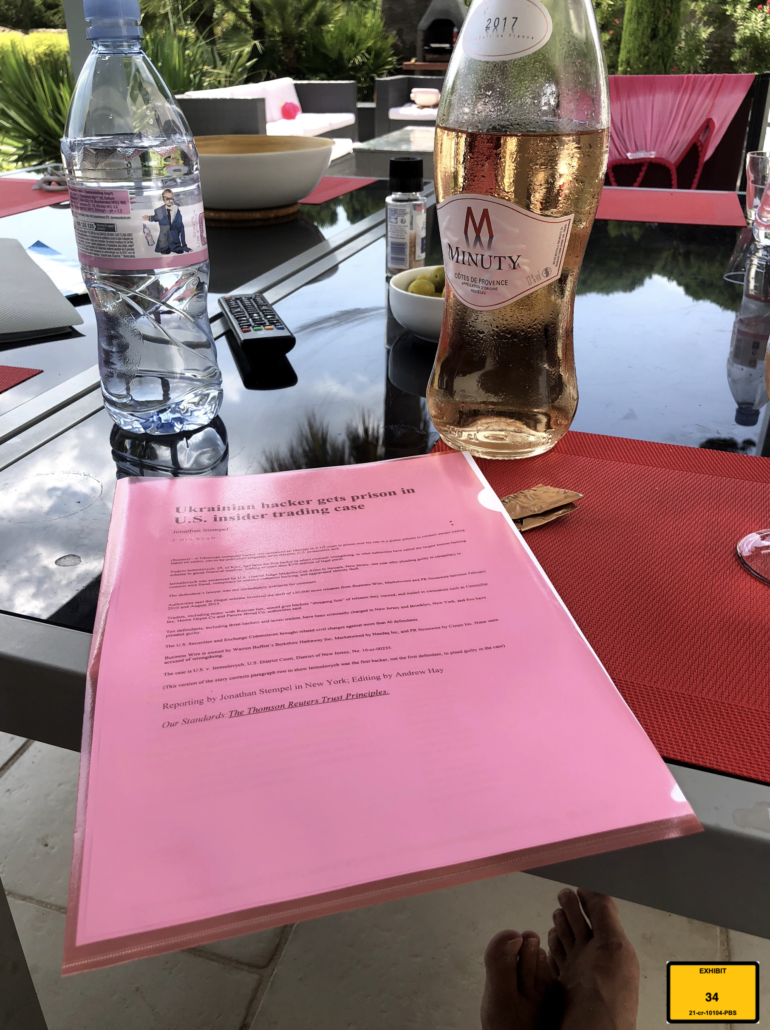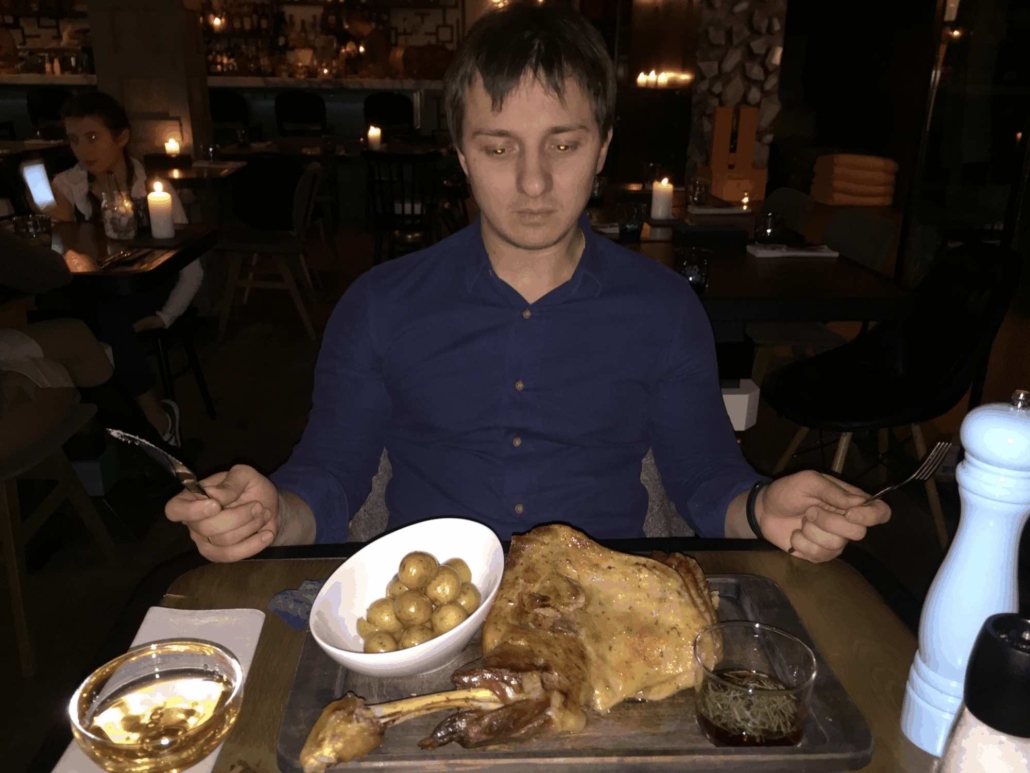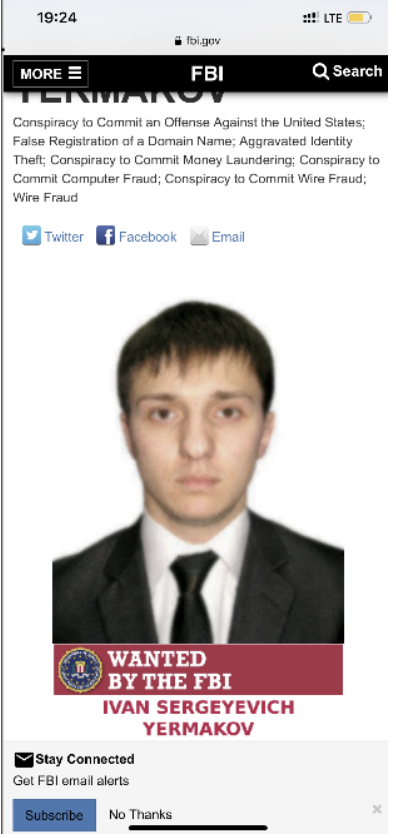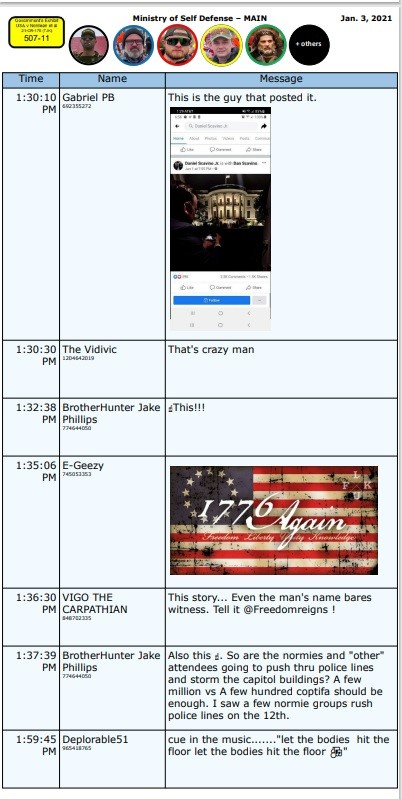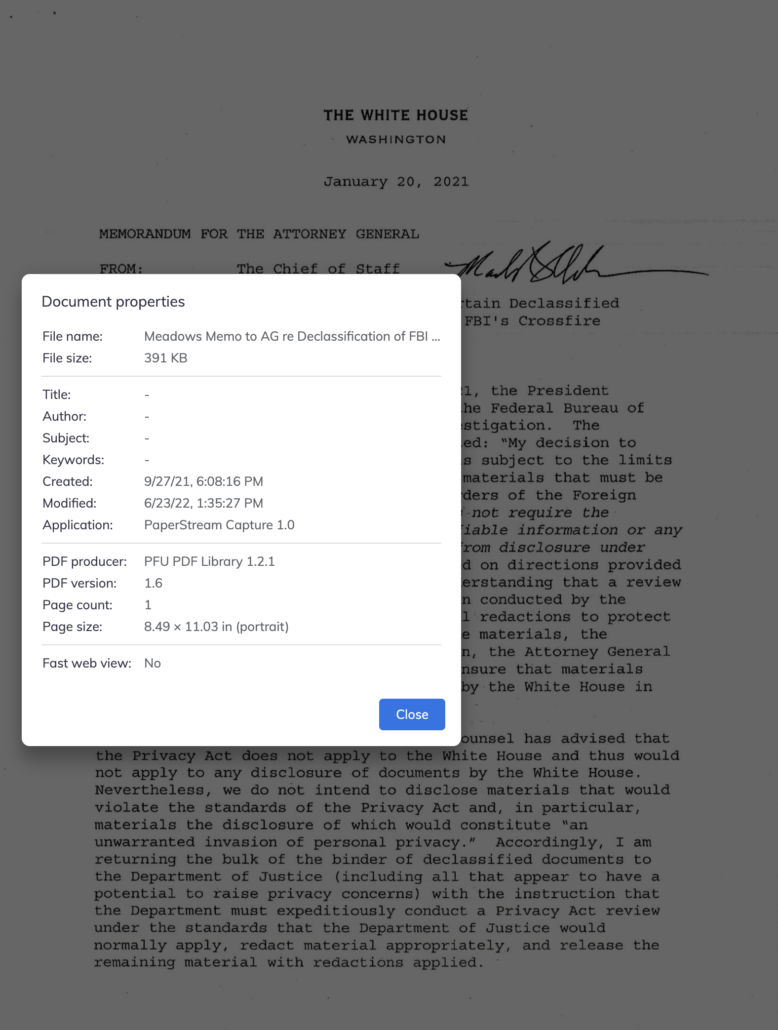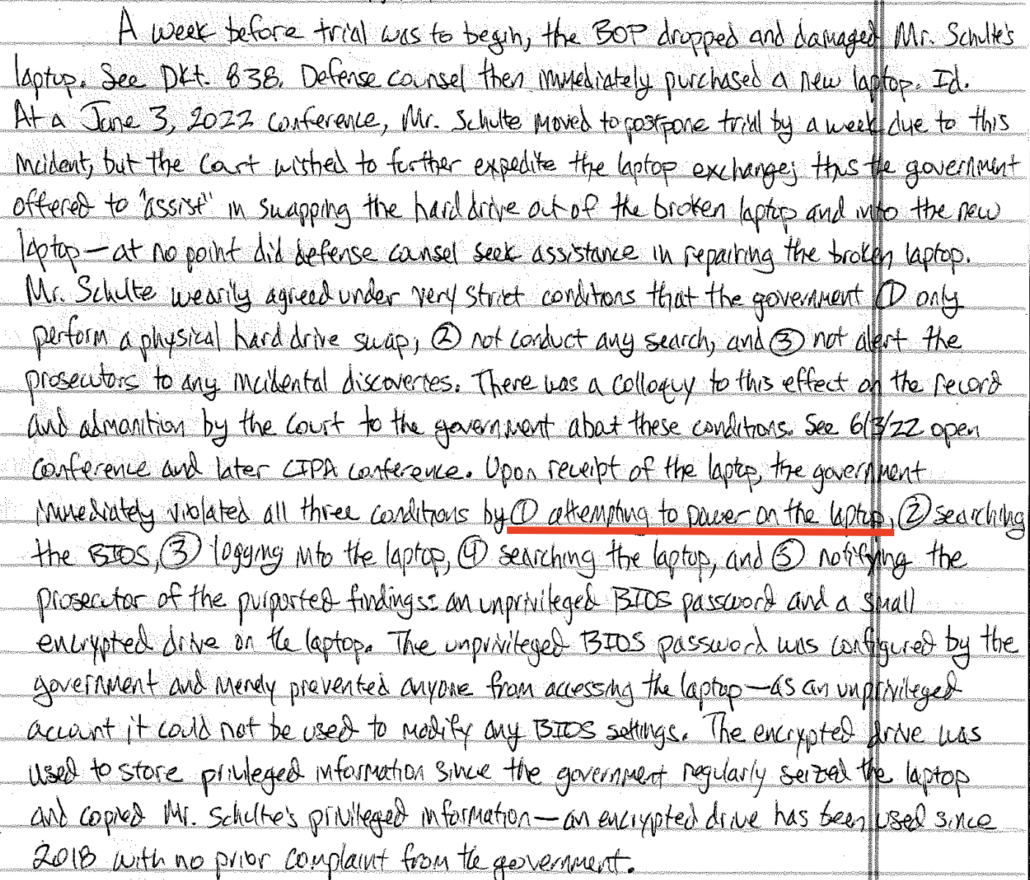 From emptywheel, 4/2: Thanks to the generosity of emptywheel readers we have funded Brandi’s coverage for the rest of the trial. If you’d like to show your further appreciation for Brandi’s great work, here’s her PayPal tip jar.
From emptywheel, 4/2: Thanks to the generosity of emptywheel readers we have funded Brandi’s coverage for the rest of the trial. If you’d like to show your further appreciation for Brandi’s great work, here’s her PayPal tip jar.
There was a moment outside of the Capitol on January 6, 2021, when Proud Boy Travis Nugent turned to Proud Boy elder and leader in the neofascist network, Ethan Nordean, and asked him: “Are we doing this?”
Then, Nugent testified this week at the seditious conspiracy trial unfolding in Washington, D.C., Nordean said nothing. But he watched Nordean move toward the Capitol and ahead to barriers thinly held—for that moment—by a scattering of police already wildly outnumbered by the crowd.
“You felt shocked but you still knew you were not supposed to go past the barriers?” Assistant U.S. Attorney Conor Mulroe asked Nugent, both of his hands resting on the edge of the courtroom podium as he leaned in toward the witness on Monday.
“Correct,” Nugent replied.
His voice was quiet, as it so often was as he testified throughout the day.
“So you fell back on the chain of command?” Mulroe said.
At almost a whisper though Nugent’s mouth was near the microphone in the witness box, he testified: “Fair statement.”
And then, Mulroe elicited, Nordean just looked at Nugent. Two years after that day, Nugent struggled to recall “exactly what totally came out” in that moment between the men as they stood in a thick crowd surrounding the Capitol. But he did remember Nordean looking at him, unresponsive to his question: Are we doing this?
When Mulroe asked Nugent whether he remembered asking Nordean a more specific question next— “are we going in?”—Nugent wasn’t sure.
But he knew he didn’t need to be told to follow when Nordean moved ahead and though he agreed with the prosecution that he is the final arbiter of his own decisions, he still rested his hand on Nordean’s shoulder as they moved together toward metal fencing that would very soon be ripped from concrete and broken into pieces.
Tensions in the crowd were high, he recalled. Nugent remembered feeling uneasy.
Yes, he said, it was true that he asked Nordean to get on a megaphone and try to calm the crowd. Yes, he said, he even went so far as to approach a police officer on site and request to borrow that officer’s bullhorn. Yes, he agreed, if they could just get their hands on that megaphone and have a Proud Boy speak to the masses, a person the crowd would respect because this was a crowd that respected and adored Proud Boys, there might be a chance to turn the temperature down.
But that chance didn’t come. When Nugent was interviewed by the FBI on May 5, he told them Nordean wouldn’t listen to him.
“I don’t think that was my exact words but it was along those lines,” he told the jury Monday.
He would go no further with Nordean and he didn’t enter the Capitol on Jan. 6. He said “correct” when asked if he understood that day that if he went ahead, he would be breaking the law. Nugent said he understood their presence interfered with police. But, he said, he didn’t know at the time what politicians were doing inside the Capitol.
Nordean stayed after Nugent left and to his knowledge, Joseph Biggs, one of Nordean’s co-defendants in the now ten-week-long trial, stayed too.
Nugent has not been charged with any crimes and it was the Proud Boys who called him as their witness with the aim of having the Washington state, fourth-degree Proud Boy tell the jury only of how there was no plan on Jan. 6 to stop the certification and that members of the group showed up merely to air their frustrations and support Donald Trump’s grievances, as well as their own, over a “stolen election.”
When Nugent came under direct from Nordean’s defense attorney Nick Smith, his answers were brief and amenable to those core arguments, even if, at times, it seemed any rehearsal or preparation for his testimony may have already gone stale in Nugent’s mind.
As a member of Henry Tarrio’s specially-created Ministry of Self Defense text channel where Proud Boys frequently discussed Jan. 6, and as a member of the group’s Boots on the Ground chat just for those Proud Boys on-site on Jan. 6, Nugent was privy to communications that prosecutors have said are integral to the alleged conspiracy to stop the certification.
When Smith questioned Nugent, he steered clear of what the witness may have seen in those communications, keeping his questions generic and short-lived.
Nugent did tell Smith, however, that when he met with Proud Boys at the Washington Monument before heading to the Capitol on Jan, 6, he didn’t remember what was said as the group congregated. Present there were defendants Biggs, Nordean, and Zachary Rehl.
He had partied the night before with Nordean and other Proud Boys at an AirBnB, he testified. A lot of people drank heavily. The next morning hangovers were in abundance. He told Smith he couldn’t recall what was said on the night of the 5th but there were discussions, he said, about what would happen the next day.
The group met at the Washington Monument and by the time they had moved from the Monument to a smattering of food trucks near the Capitol to eat, Nugent told Smith the Proud Boys, and in particular, Ethan Nordean, had said repeatedly they just wanted to go back to their hotels or AirBnBs to relax for the day. A conversation ensued among Proud Boys at the food trucks too but Nugent told Smith he couldn’t recall whether it was then that a “decision was ever really made” about where to go next.
He described it as “chaotic” and struggled to pin down particulars. The situation, he offered, “devolved” quickly.
When Proud Boys went to the nearby Peace Circle next, Smith didn’t work to fish out specifics.
He, like Mulroe, elicited that Nugent was “shocked” when people started going over barriers at the Peace Circle and prompted by Smith, Nugent said it felt “spontaneous.” He told the jury, he “just didn’t know it was going to happen.” People were taking pictures of them that day wherever they went and although Nugent and Nordean stayed close to each other and often conversed, Nugent couldn’t say whether Nordean brought up using force at the Capitol as they marched toward it.
“I kind of perceived the whole thing as a photo op,” Nugent said. “A publicity stunt.”
He later told Smith Proud Boys were “pushed up” by the crowd into areas he knew they shouldn’t be.
Like the cows, pigs, and chickens that Nugent raises, he said, it was a “herd mentality.”
Then, touching on another core theory from the defense—that Proud Boys were incited not the other way around—Nugent testified that a man who introduced himself as a pastor had approached Nordean and asked Nordean to go through the barriers. Nugent recalled Nordean had “basically denied” the request but Nugent had no further particulars.
When Smith asked him about a rowdy man in a star-spangled jacket—identified as Proud Boy Chris Quaglin of New Jersey—who appeared to be in an altercation with police, Nugent in one breath told Smith he could see Nordean grabbing the man as if to stop him but in another breath, Nugent testified that he couldn’t get a clear read on what was actually happening. It was just his perception, he said, that Nordean was trying to stop the man. Quaglin now faces multiple charges, including assault. He has pleaded not guilty.
After the 6th, Nugent stayed in the Proud Boys text channels for a day or two. He suggested to members that the chats be deleted. He was worried, he testified, that “antifa groups” would infiltrate the chats and doxx him or others. He was “highly doxxed,”he said.
Under the friendly glow of direct examination, Nugent, in sum, aligned himself with the defense’s narrative: Proud Boys weren’t at the Capitol on Jan. 6 to incite violence or to force their will.
But once Mulroe began asking the questions, evidence emerged of Nugent celebrating violence and in particular, the violence exacted by the Proud Boys.
That evidence included an illustration of Proud Boys strangling people, the animated eyes of their victims bulging. This was found on Nugent’s Google drive. He admitted, there were times he also celebrated the aggressive use of force. He admitted that violent propaganda videos showing Proud Boys clashing at events or at rallies or in the streets were effective recruitment tools. And when Mulroe asked Nugent if Proud Boys, like himself, recruited people aggressively to “attack people he didn’t agree with,” Nugent affirmed.

And key to the prosecution’s argument that Proud Boys developed a growing disdain for law enforcement in the run-up to Jan. 6 that fueled the intensity of the violence that day, Mulroe showed jurors a series of texts where Nugent urged Proud Boys less than a week after the 2020 election that they couldn’t allow cops “to become social justice warriors.”
Most cops were “good dudes,” Nugent wrote on Nov. 9, 2020, but if they chose to “play games” then it would be “time to play.” And if necessary, Proud Boys would turn their back on police, he added. Other text messages showed Nugent discussing how Proud Boys shouldn’t “wear colors” or their traditional black and yellow, at events. He testified this could help them conceal their identities in public.
This direction was one Tarrio had handed down to members for pro-Trump rallies in November and December 2020. And the same directions came down in the group’s “New Ministry of Self Defense” channel on Jan. 6, 2021.
That channel was created after Tarrio was arrested on Jan. 4 for burning a Black Lives Matter banner and included many of the same participants as the original Ministry of Self Defense chat like Biggs, Nordean, and Rehl. Nugent testified on cross that he told Proud Boys the original chat should be nuked. They knew police had Tarrio’s phone and they worried, he said, that chats could potentially come into law enforcement’s hands.

With Tarrio arrested, it was Proud Boy Charles Donohoe who told the “new” ministry on Jan. 6 what to do, where to meet, and importantly, not to wear colors. Less than a week before that text from Donohoe, jurors saw messages where Nugent told Proud Boys “the big thing with this event is we need to get everyone focused on the goal of the event and not getting Proud Boys their fourth [degrees].”
In another Ministry chat dubbed “MOSD Main 2,” Nugent worked to fill the vacuum left by Tarrio’s arrest. It wasn’t his idea, he testified, but he told the group they needed to fall under Nordean. People looked up to Nordean, he said in court this week. He was a leader. It was fair, Nugent agreed, to describe Nordean as having a “heroic” reputation among Proud Boys because of his fighting skills. Namely, for his “punch heard round the world.” (Prosecutors were unable to persuade presiding Judge Timothy Kelly to admit footage featuring the punch that made Nordean famous among the far right.)
Nugent wasn’t a hero like Nordean, he testified. He was a “nobody.”
“I’m nobody but I’m doing what I can to help my brothers,” Nugent wrote in a text on Jan. 5 in the MOSD Main 2 chat.
They were “working a plan,” Nugent wrote. They would meet in the morning and continue on with the plan, he added. Things had clearly “went south” after Tarrio’s arrest, Nugent wrote, “but they are continuing on with it tomorrow.”
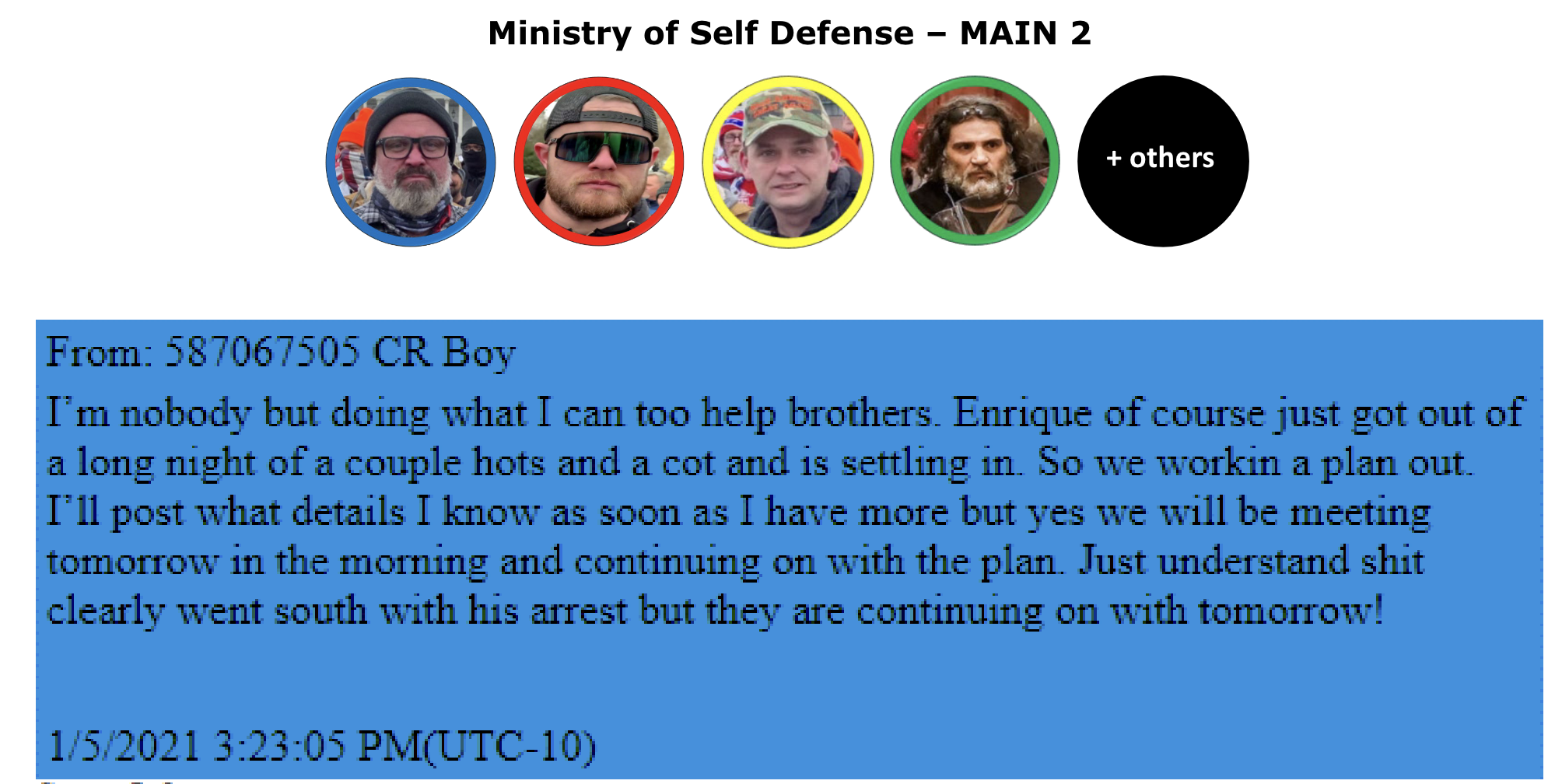
When Mulroe asked Nugent about his use of the word “they,” Nugent said it was a “grammar mistake.”
Though he had told Smith he couldn’t remember much, and in particular, the meeting at the AirBnB on the eve of the attack, he told Mulroe “yes” when asked if they discussed tactics for Jan. 6, including using radios, breaking into small teams and following the command’s leadership.
“Even if you didn’t fully understand the plan, you were supposed to follow?” Mulroe asked.
“Fair statement, yeah,” Nugent replied.
In addition to Nugent’s testimony, jurors also heard from defense witness Michale Emanuel aka Michale Graves, a former singer from the punk band The Misfits. Graves became a Proud Boy in 2020 and traveled to D.C. for Jan. 6 though he didn’t march on the Capitol.
The only plan Graves could speak of was a plan to play a concert at an AirBnB on Jan. 5. That concert was moved to Jan. 6 after Tarrio was arrested. On the 6th, Graves sang the National Anthem at a Latinos for Trump rally in the morning, and then, he testified, he and the Proud Boys had considered going back to the AirBnB around 3 p.m. to hang out before Graves’ nighttime performance.
Graves told defense attorneys on direct he wanted the concert because it would “keep people off the street.” Yet, despite all testimony about the concert, he told Assistant U.S. Attorney Jason McCullough on cross, he and the Proud Boys didn’t communicate on Jan. 6, really, at all. The only text he sent to Nordean on Jan. 6 was a singular “I’m safe” long after the Capitol had been breached.
There was no apology for missing the show and no discussion otherwise found.
When McCullough began grilling him about his conduct on social media, Graves grew defensive. He had posted messages online saying Proud Boys were having lunch when the Capitol was breached. Graves said he may have read that in a media report.
“And you told the public that Nordean and Biggs did nothing wrong?” McCullough asked.
Graves said so online, but in court, he conceded that maybe they had trespassed.
“What I know is a fact is there was not some elaborate plan to take over the Capitol on Jan. 6,” he said before acknowledging that he was never part of the Ministry of Self Defense chat nor Boots on Ground chats.
On Tuesday, the defense’s third witness, Proud Boy photographer Eddie Block took the stand, his service dog, a St. Bernard named Donald J. Trump, at his side.
Block told defense attorneys that Proud Boys didn’t come to Washington on Jan. 6 with plans for violence or to interfere with police or the certification.
“No sir,” he told Nordean’s attorney Nick Smith, “we were just there to get our voices heard.”
Proud Boys only engage in violence when they need to self-defend, he said. They only brought radios to D.C. on Jan. 6 purely because they were worried about being able to “scout antifa out” and warn each other if “antifa” were spotted. From the stand Tuesday, Block said he believes antifa had a large presence at the Capitol on Jan. 6. This has not been supported by any credible evidence. Block told jurors it was a “gut feeling.”
A self-proclaimed documentarian, Block filmed Proud Boys, including the defendants, marching on the Capitol on Jan. 6. He thought they would get as close as they could to the barriers but not past them, he said. Appearing to play things down further, Block said for two weeks before Congress met to certify the election, “everyone was saying you gotta storm the Capitol” on social media. “Normies” would use that phrase all the time, he added.
Prosecutors have argued that “normies” and Proud Boys alike were tapped by the defendants on Jan. 6 as “tools” of their alleged conspiracy. In effect, prosecutors have argued Proud Boys needed more muscle and more numbers than they had available to stop the certification and knew it.
Like Nugent, Block testified that Jan. 6 was a full day of photo opportunities for the Proud Boys. Block fawned over Joseph Biggs, calling him a hero and telling jurors on Tuesday anyone would want their picture taken with the former InfoWars contributor because he had won a Purple Heart.
As Smith guided Block through video clips from Jan. 6, the same arguments emerged: there were mysterious men in the crowd who appeared to speak to the defendants before the breach kicked off. (Ray Epps has been pointed to indirectly and directly with zeal by defense attorneys over the course of the trial but that conspiracy theory has long been debunked.)
There was no plan, Block said, not to stop Congress and not to interfere with police.
Under cross-examination by Assistant U.S. Attorney Erik Kenerson, Block first said planning was non-existent and that no one prior to 9:45 a.m. on Jan. 6 invited him to film the Proud Boys. Nordean didn’t ask nor did Tarrio, he testified. They just knew he was going to be there and they knew, he said, “wherever I am, there’s cameras.”
Ultimately, he did livestream from Washington on Jan. 6. He told prosecutors he’s not made much money on his footage from that day. Unprompted, Block said he averages about $40 a month from his channel featuring Jan. 6 footage on YouTube.
“It’s not like I’m making money on this,” he said.
But one of the ways he could make money, Kenerson pressed, was to get his name out there.
Agreeing easily with the prosecutor, Block replied: “That’d be correct.”
There was nothing wrong with filmmakers or videographers trying to earn a buck for their work, Kenerson argued. Then the prosecutor shared information with jurors they might not otherwise have heard. Block drove across country from Fresno, California to Washington, D.C. to testify. He live-streamed that too and set up a fundraiser online.
“And one of the things you said was, if you got $1,000, you would put your dog in a Donald Trump vest?’ Kenerson said.
“Yeah,” Block said. “It’s his name. Donald J, Trump. I call him Donnie because I live in California and if I say Trump in public, someone may attack me.”
Ever the self-proclaimed adherents of self-defense, Block told jurors that Proud Boys didn’t start fights, they finished them.
Testing that claim, Kenerson brought Block’s attention to footage from Portland, Oregon. A man with Proud Boy garb approaches a van in a parking lot. There are several men surrounding the vehicle before suddenly, a Proud Boy starts unloading a stream of chemical spray with some sort of paintball-gun-looking apparatus into the van, overwhelming the driver and forcing the person to drive off road.
As the video played, Block testified unprompted. Again.
The van had come to the location to attack Proud Boys. The government was taking things out of context, he said.
“You’re making it look like we did something to those people. I saw the man pull in there with a can of mace,” Block said. “What were we supposed to do?”
“You don’t start fights?” Kenerson volunteered.
‘Right,” Block said. “We’re finishing it.”
But at another time, it didn’t appear Proud Boys were only about “finishing” fights. Pulling up a series of text messages from Dec. 13, 2020, Kenerson asked if Block had once “concocted” a plan to lure “antifa” so Proud Boys could ambush and assault them.
In the text chain, Block appeared livid that Proud Boy Jeremy Bertino had been stabbed the night of the Million MAGA March in D.C. just one day earlier. Bertino has since pleaded guilty to seditious conspiracy and testified on behalf of the prosecution last month.
“I don’t care. I say we let me be the sacrificial lamb next time,” Block wrote. “I’ll sneak in. Get their attention on me.”
Block, who is disabled, had 60 operations by that point and told Proud Boys that he could “take the pain.”
“You don’t fuck with my brothers like that,” he groused.
But he told jurors, at first, no one ever took him up on the offer.
Then Kenerson showed him where a Proud Boy identified by the handle, “RC Proud Nate” told Block: “Be live while your scooter suddenly dies right while the exact street corner you are crossing is visible.”
Block replied: “I’ll just say, don’t worry folks, I’ll catch up like I did last night.”
Block’s testimony will resume on Wednesday at 9 a.m. and it will be left to the defense to attempt damage control after two hard days where witness testimony has withered under the Justice Department’s scrutiny.
Update: Exhibits from Nugent’s testimony added.
Update: Correction – an earlier version of this story stated the van video from Oregon was from years prior to Jan. 6. It was from August 2021.


